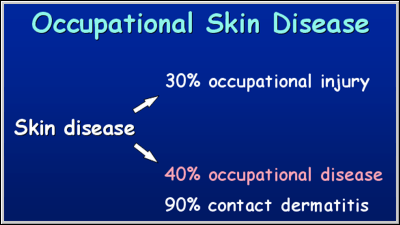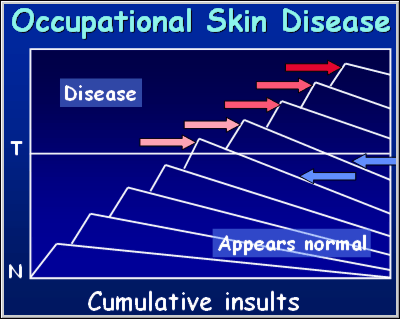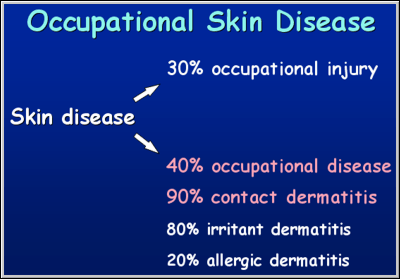 |
| Module 4: Occupational Skin Disease - |
 |
| Module 4: Occupational Skin Disease - |

Are any skin diseases more common than others in the work place? Studies done in specific work environments have been published showing task-related associations. Overall, 90% of occupational disease is due to contact dermatitis. Many biological occupational diseases never get reported as exposed workers know the risks involved and do not necessarily seek medical attention.

Contact dermatitis can be either immune or non-immune mediated. It usually presents as urticaria and/or eczema. Both the immune and non-immune forms of contact dermatitis are due to direct exposure to the compounds. In certain rare circumstances a combination of the chemical (chromophore) plus light causes the skin condition. These are known as phototoxic and photoallergic reactions respectively. These conditions will not be discussed specifically as they are clinically similar to contact dermatitis, only dependent on associated light for their manifestation.
Urticaria represents type 1 allergy, however both immune and non-immune mechanisms underlie its presentation.
Non-immune causes of urticaria mediation include heat, vibration, pressure and a variety of chemicals (codeine, salicylates and alcohol). These all cause mast cell degranulation directly without involving IgE.
Immune mechanisms of urticaria are mediated via IgE hypersensitivity reactions. These are well known and have received prominence in recent years because of the epidemic of latex allergy.
Eczema likewise can be non-immune or immune mediated and it is known as either irritant or allergic contact dermatitis respectively.
Irritant dermatitis is more common than allergic contact dermatitis but perhaps not as well recognised.

You can see an animation in which cumulative insults to the skin are represented as inverted triangles enclosed in a box. (Click outside the animation window to close it)
The horizontal line represents the point above which a person is aware that damage is occurring to the skin because they start developing symptoms. This is known as the irritant threshold. The threshold varies dependent on the area of the skin involved, pre-existing skin disease and individual susceptibility.
Insults that occur below the threshold level, although causing damage to the skin barrier do not result in abnormal appearing skin. Normal skin is represented by the baseline.
Any insult or combination of insults that result in sustained damage to barrier function results in skin disease (irritant dermatitis). This is shown as the lines above the threshold.Numerous and varied insults occur fairly rapidly and multiple times a day. The time for damage is relatively short in comparison to the time required for recovery and repair. After each insult, given time, the normal barrier function of the skin will recover. However, should one insult occur before repair and recovery of a previous insult is complete, cumulative damage results in the symptoms of dry skin. If one recognises this as a warning and takes avoidance measures, the problem will resolve. In the real world however, once the skin appears normal clinically (no signs and symptoms), it is assumed that barrier function has been restored and preventative measures are no longer followed. The consequences are that the workers suffer intermittent bouts of worsening skin. Over holiday periods and weekends the skin may recover only to break down on return to work. Do not forget that at home there are also multiple irritant exposures that can prevent repair during off periods. In fact the skin may even worsen on holidays.
As more and more damage occurs with less time being given for recovery, skin changes become more apparent, persistent and intractable. Workers with this form of irritant dermatitis are difficult to control.
With persistent damage to the skin barrier function in the setting of numerous and multiple allergen exposures, the patient may now develop compound irritant and allergic dermatitis.
Allergic dermatitis occurs in susceptible individuals when exposure to the allergen is at a high enough concentration to induce sensitisation. Once sensitisation has occurred, even small exposures to the allergens will precipitate disease. Workers with allergic contact dermatitis when removed from exposure may show no signs and symptoms. They are still handicapped, as they cannot go back into a work environment where exposure will occur. This is in contrast to pure irritant dermatitis where, once skin has recovered and provided that protective measured are ensured, the worker can continue with work.

Of the 90% contact dermatitis that accounts for occupational skin disease, 80% are due to irritant dermatitis and 20% to allergic dermatitis. In reality, there is probably an overlap between irritant and allergic presentations
.
Postgraduate Diploma in Occupational Health (DOH) - Modules 3 – 5: Occupational Medicine & Toxicology by Prof Rodney Ehrlich & Prof Mohamed Jeebhay is licensed under a Creative Commons Attribution-NonCommercial-ShareAlike 3.0 Unported License.
Permissions beyond the scope of this license may be available at http://www.healthedu.uct.ac.za/